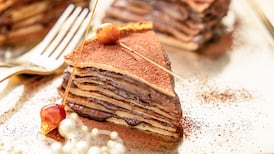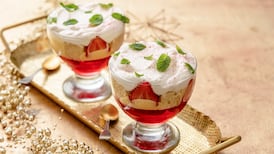Ingredients
- <ul> <li>Choux bunsMakes 28 little choux buns130g plain white flour </li> <li>100g butter</li> <li>300ml cold water</li> <li>3 large free range eggs or 4 small free range eggs, lightly beaten</li> <li>Pastry cream filling4 medium free-range egg yolks (preferably organic)</li> <li>65g caster sugar</li> <li>15g plain flour</li> <li>15g cornflour</li> <li>350ml whole milk</li> <li>Seeds from a vanilla pod</li> <li>Caramel You’ll need a sugar thermometer 600g caster sugar</li> <li>450ml water</li> <li/> </ul>
For the choux pastry
Preheat the oven to fan 200 degrees and line two baking sheets with parchment.
Sift the flour onto a sheet of baking paper. In a medium pan, gently heat the water and butter.
Once the butter has melted, increase the heat and bring to the boil, remove and immediately tip in the flour all at once, beating thoroughly with a wooden spoon until the mixture forms a smooth ball – this will take a minute or so.
Beat in the eggs, a little at a time, making sure each addition is fully incorporated into the dough. You’ll then have a thick, smooth, shiny paste. Leave to cool a little.
Spoon the paste into a piping bag with a wide nozzle, I used a 1.5cm nozzle. Pipe onto the lined baking trays, mine were about 3cm in diameter. Leave enough space between each one for the pastry to rise and expand.
Bake the buns for 20 minutes, then remove from the oven and reduce the temperature to 180 degrees.
Quickly turn the buns over and prick each one with a cocktail stick to allow the steam to escape.
Return to the oven, bottoms up, and bake for a further five to seven minutes, until golden and crisp. Transfer to a wire rack. Bake the remaining choux pastry in the same way – remember to turn up the oven to 200 degrees before you start again. Leave to cool completely.
For the filling
In a large mixing bowl, whisk together the eggs and sugar until they turn a pale blonde colour. Whisk in the flour and cornflour and set aside.
Scrape the seeds from the vanilla pod and add to the milk. Place the milk and vanilla in a heavy-bottomed saucepan, bring to a gentle simmer, stir frequently. Remove pan from the heat and let cool for 30 seconds.
Slowly pour half of the hot milk onto the egg mixture, whisking, then return the mixture to the remaining milk in the pan. It is important to slowly pour the hot milk onto the cold eggs before you return to the pan to prevent the eggs from scrambling. Bring back to the boil and simmer for one minute, whisking continuously, or until smooth.
Pour the pastry cream into a clean bowl and dust with icing sugar to prevent a skin forming. Cool as quickly as possible, by sitting in another larger bowl of ice water. When cooled, refrigerate until needed. When it is cool, fold some whipped cream into the pastry cream – about 25% whipped cream to 75% pastry cream – this gives a lighter consistency. Spoon the mix into a piping bag with a small nozzle and fill the choux buns with it
To assemble
Start by making the caramel, which will act as the glue. Stir sugar and water in a pan over a gentle heat. Once dissolved, raise the temperature to boiling. Insert your sugar thermometer. Do not stir whilst boiling. Boil as rapidly as possible to 154 degrees, at which point the caramel will turn amber in colour.
When the required temperature has been reached, remove the pan from the heat. You have to work quickly as it gets hard fast, in fact a second pair of hands are worth their weight in caramel!
Holding each choux bun on its side, dip the top and side with caramel, so each will stick to the one beside it. Be careful as it will be very hot. Arrange the buns around the base of the mould. Continue dipping and layering the buns up around the mould, until you reach the top. If the caramel gets too thick, briefly return it to the heat to warm through. Once assembled, leave to set for at least 30 minutes.
You can serve on the mould or very carefully lift the finished article off the mould. You will need to loosen any hardened caramel from the base and then it will slip off the mould. Place on a flat serving plate.
Decoration
Croquembouche is usually decorated with spun sugar – it might take you a while to get into the swing of it.
Using the same caramel as before, dip the back of a wooden spoon into the caramel and using the back of another wooden spoon, pat the spoons together and work the caramel back and forth until it becomes pliable and stretches into fine strands.
Using the two spoons, stretch and twist the caramel around the croquembouche. This will take some practice but there is enough caramel to make more than you need so persevere. Allow your creativity to run wild and decorate with little flowers.













